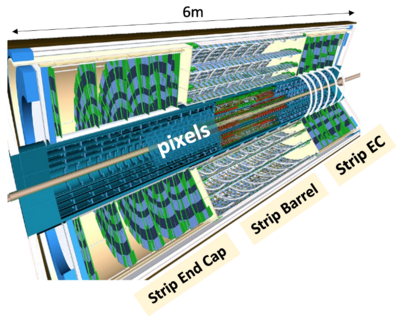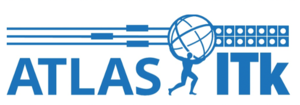Difference between revisions of "ITk Endcap Homepage"
m (improve format) |
|||
| (11 intermediate revisions by 2 users not shown) | |||
| Line 1: | Line 1: | ||
| − | == | + | == ATLAS ITk project at Nikhef == |
| + | Author: Andrea García Alonso | ||
| − | + | [[File:ITk_representation.png|alt=|frameless|400x400px]] [[File:ATLAS ITk logo.png|frameless]] [[File:End-cap C in the Nikhef cleanroom 2-10-23.jpg|frameless|306x306px]] | |
| − | + | The inner detector of the present ATLAS experiment has been designed and developed to function in the environment of the present Large Hadron Collider (LHC). At the ATLAS Phase-II Upgrade, the particle densities and radiation levels will exceed current levels by a factor of ten. The instantaneous luminosity is expected to reach unprecedented values, resulting in up to 200 proton-proton interactions in a typical bunch crossing. The new detectors must be faster and they need to be more highly segmented. The sensors used also need to be far more resistant to radiation, and they require much greater power delivery to the front-end systems. At the same time, they cannot introduce excess material which could undermine tracking performance. For those reasons, the inner tracker of the ATLAS detector was redesigned and will be rebuilt completely. | |
| − | + | ||
| + | The ATLAS Upgrade Inner Tracker (ITk) consists of several layers of silicon particle detectors. The innermost layers will be composed of silicon pixel sensors, and the outer layers will consist of silicon microstrip sensors. Nikhef work focuses on the strip region of the ITk. The central part of the strip tracker (barrel) will be composed of rectangular short (~ 2.5 cm) and long (~5 cm) strip sensors. The forward regions of the strip tracker (End-Caps) consist of six disks per side, with trapezoidal shaped sensors of various lengths and strip pitches. At Nikhef, we are producing the two End-caps of the ITk Strip detector. | ||
| − | == | + | ==End-cap construction and petal installation at Nikhef== |
| − | [http://wiki.nikhef.nl/atlas/ITk_Endcap_At_Nikhef ITk Endcap | + | [http://wiki.nikhef.nl/atlas/ITk_Endcap_At_Nikhef ITk Endcap at Nikhef] |
| − | + | [[DAQ systems|DAQ systems: FELIX]] | |
| − | + | [[DAQ systems: Genesys]] | |
| − | == | + | ==General ATLAS documentation== |
===ITk specific=== | ===ITk specific=== | ||
| + | *[https://indico.cern.ch/event/854551/ ITk common and strip global structure PRR] | ||
| + | *[https://indico.cern.ch/event/1072662/ ITk Strip Integration FDR] | ||
| + | *[https://atlas-itk-scripts.web.cern.ch/atlas-itk-scripts/scripts/schedule?ts=3012&pid=3&wbsid=30 ITk strip schedule browser] | ||
| + | *[https://edms.cern.ch/ui/#!master/navigator/project?P:1556598488:1505718364:subDocs EDMS: Review outcomes] | ||
| + | *[https://edms.cern.ch/ui/#!master/navigator/project?P:1466439045:1547086193:subDocs EDMS: Global mechanics documents] | ||
| + | ==== ITk Production Database ==== | ||
| + | *[https://itkpd-test.unicorncollege.cz/dashboard ITk Production Database] | ||
| + | *[https://itk.docs.cern.ch/ ITk Production Database Documentation] | ||
| + | *[https://gitlab.cern.ch/atlas-itk/sw/db/production_database_scripts Production Database Scripts] | ||
| + | *[https://uuapp.plus4u.net/uu-bookkit-maing01/41f76117152c4c6e947f498339998055/book/page?code=52022479 ITk database command booklet] | ||
| + | |||
| + | |||
| + | == How to upload files to this twiki == | ||
| + | If you want to upload a file that needs to be stored and/or added to a page, copy your file to /www/pub/experiments/atlas/ITk/data/[Your Name]. If you do not have a directory with your name yet, please contact Dylan van Arneman. For any other questions regarding the ITk EC twiki contact Dylan. | ||
Latest revision as of 11:48, 30 October 2024
ATLAS ITk project at Nikhef
Author: Andrea García Alonso
The inner detector of the present ATLAS experiment has been designed and developed to function in the environment of the present Large Hadron Collider (LHC). At the ATLAS Phase-II Upgrade, the particle densities and radiation levels will exceed current levels by a factor of ten. The instantaneous luminosity is expected to reach unprecedented values, resulting in up to 200 proton-proton interactions in a typical bunch crossing. The new detectors must be faster and they need to be more highly segmented. The sensors used also need to be far more resistant to radiation, and they require much greater power delivery to the front-end systems. At the same time, they cannot introduce excess material which could undermine tracking performance. For those reasons, the inner tracker of the ATLAS detector was redesigned and will be rebuilt completely.
The ATLAS Upgrade Inner Tracker (ITk) consists of several layers of silicon particle detectors. The innermost layers will be composed of silicon pixel sensors, and the outer layers will consist of silicon microstrip sensors. Nikhef work focuses on the strip region of the ITk. The central part of the strip tracker (barrel) will be composed of rectangular short (~ 2.5 cm) and long (~5 cm) strip sensors. The forward regions of the strip tracker (End-Caps) consist of six disks per side, with trapezoidal shaped sensors of various lengths and strip pitches. At Nikhef, we are producing the two End-caps of the ITk Strip detector.
End-cap construction and petal installation at Nikhef
General ATLAS documentation
ITk specific
- ITk common and strip global structure PRR
- ITk Strip Integration FDR
- ITk strip schedule browser
- EDMS: Review outcomes
- EDMS: Global mechanics documents
ITk Production Database
- ITk Production Database
- ITk Production Database Documentation
- Production Database Scripts
- ITk database command booklet
How to upload files to this twiki
If you want to upload a file that needs to be stored and/or added to a page, copy your file to /www/pub/experiments/atlas/ITk/data/[Your Name]. If you do not have a directory with your name yet, please contact Dylan van Arneman. For any other questions regarding the ITk EC twiki contact Dylan.


